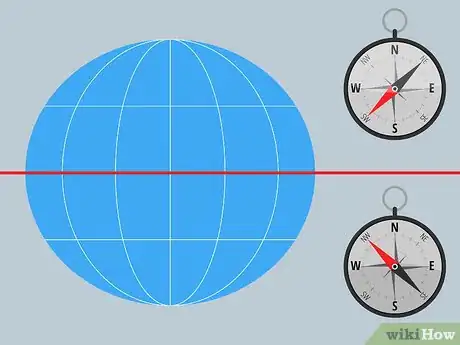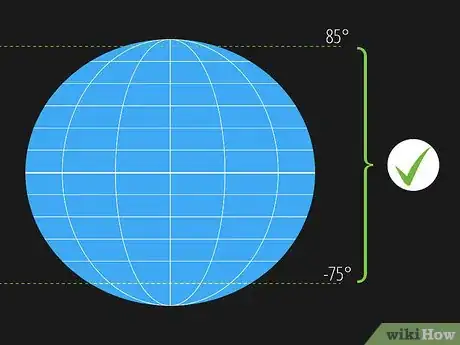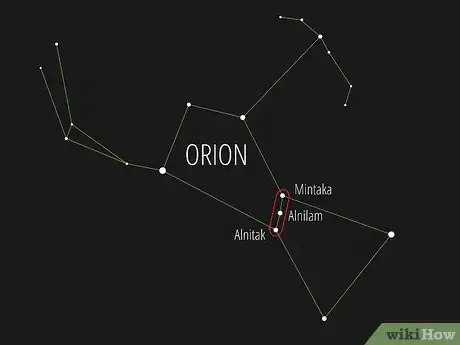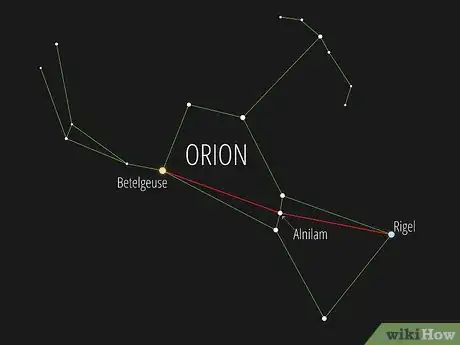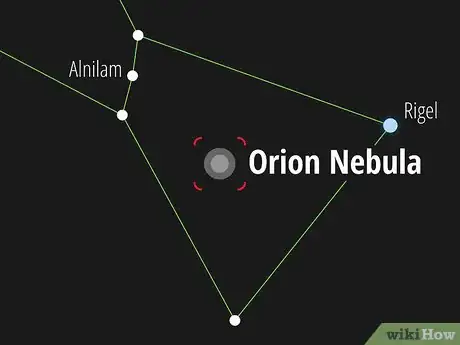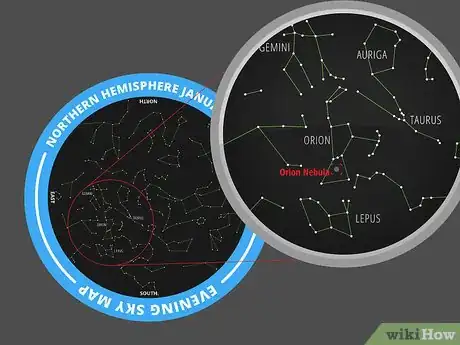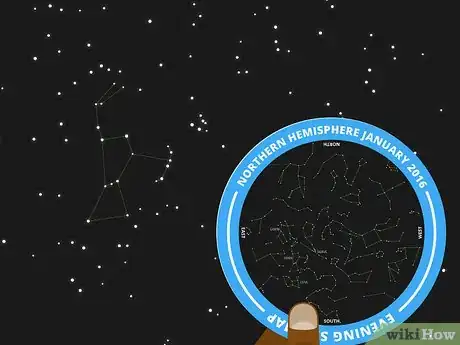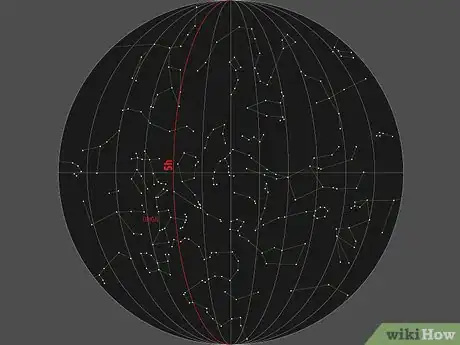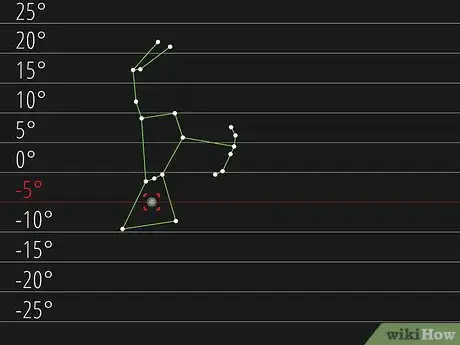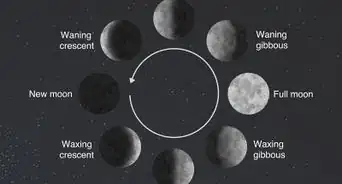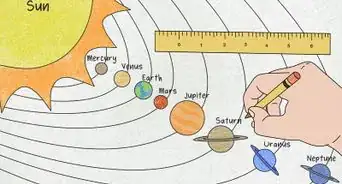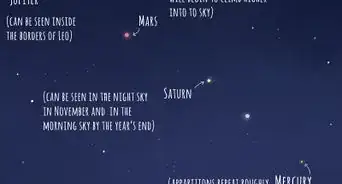This article was co-authored by wikiHow Staff. Our trained team of editors and researchers validate articles for accuracy and comprehensiveness. wikiHow's Content Management Team carefully monitors the work from our editorial staff to ensure that each article is backed by trusted research and meets our high quality standards.
There are 9 references cited in this article, which can be found at the bottom of the page.
This article has been viewed 80,687 times.
Learn more...
The Orion Nebula, also known as M42, is a beautiful deep-sky object in the constellation Orion. While most nebulae (clouds of interstellar gas and dust) are difficult or impossible to see with the naked eye, M42 is quite easy to spot in the night sky for much of the year. With a little guidance, you’ll be able to spot the Orion Nebula with your eyes, binoculars, or your telescope.
Steps
Locating the Orion Nebula Using Other Stars
-
1Wait for the right time of year. Because of the slow orbit of the earth around the sun, the nebula is not visible all year round. The nebula is visible from late autumn to early spring. The constellation Orion, which contains the Orion Nebula, is highest in the sky around midnight in mid-December.[1]
-
2Look in the right part of the sky for the nebula. Due to the spherical nature of the earth, the direction the nebula will appear in is relative to your position on our planet. In the northern hemisphere, look to the southwest. In the southern hemisphere, look to the northwest.[2]Advertisement
-
3Identify the best latitude to see the Orion Nebula from. The nebula is best seen from latitudes of 85 and -75 degrees. In other words, if you’re hanging out with polar bears in the North Pole or penguins in the South Pole, you won’t be seeing the Orion Nebula.
- You can identify what hemisphere you’re in by looking at a map. If the country you’re in lies south of the equator, you’re in the southern hemisphere. If the country you’re in lies north of the equator, you’re in the northern hemisphere.
-
4Find the Belt of Orion. The Belt of Orion is one of the most recognizable asterisms (a group of stars in an identifiable cluster). It is composed of three very bright stars -- Alnitak, Alnilam and Mintaka -- in a line, relatively equidistant from one another. The Belt and the Orion Nebula both lie within the constellation Orion, so knowing where the Belt is will help you know you're in the neighborhood of the nebula.[3]
-
5Find Betelgeuse and Rigel. If you imagine the Belt of Orion as perfectly parallel to your line of sight, and thus forming a vertical line, Betelgeuse and Rigel are two stars which sit on either side of the Belt. The path from Betelgeuse through Alnilam (the middle star in the Belt) and on to Rigel forms an almost straight line. Rigel and Betelgeuse are about equidistant from Alnilam.
- Betelgeuse is a red supergiant and, true to its name, glows a dull red-orange. It is located up and to the left of the Belt of Orion if you’re in the northern hemisphere, and down and to the right of the Belt if you’re in the southern hemisphere.[4]
- Rigel is a blue-white star located down and to the right of the Belt of Orion if you’re in the northern hemisphere, and up and to the left if you’re in the southern hemisphere.[5]
-
6Identify the Orion Nebula. The Orion Nebula is located just to one side of the line between Rigel and Alnilam, the middle star in the Belt of Orion. The nebula is a faint, fuzzy blue patch in the Sword of Orion, an asterism composed of Iota Orionis (just below the Orion Nebula if viewed from the northern hemisphere), the Orion Nebula, and NGC 1981 (an open star cluster visible just below the Orion Nebula if viewed from the northern hemisphere).[6]
Use a Star Chart to Find the Nebula
-
1Orient yourself to the chart’s directions. In other words, hold your star chart in such a way that the compass directions are aligned in the same way your body is. If, for instance, you’re facing south (as you should to see M42), hold the star chart in such a way that the southern edge of the chart is at the bottom and the northern edge is at the top. Ensure your star chart is for the current season.[7]
-
2Identify nearby stars and constellations. Unless you have an exquisitely detailed star chart, the Orion Nebula will not be explicitly labeled, though it should appear as a point on the chart. However, using the star chart to locate nearby objects in the night sky will help you find it.
- The Orion Nebula is located just to one side of the line between Alnilam (the middle star in the Belt of Orion) and Rigel in the constellation Orion. These and other major features of the night sky will provide relative guide you to where you can locate it.
- There are several major stars and constellations around M42 which can help you locate it. The Belt of Orion is one such constellation. Locating it with your star chart should be easy.
- The constellation Orion is a major constellation and lends the Orion Nebula its name. Orion is located at the intersection of Taurus, Lepus, and Gemini.
-
3Lift the star chart above your head. Your star chart will mirror the appearance of the night sky. Think of it as an astronomical map. With the chart in an overhead position, you can easily identify the various stellar objects in your quadrant of the sky. Find the stellar objects you identified as near to M42, then use their relative positioning to find it.
- If your star chart does have a label for M42, your job is much easier. Use it to locate the nebula.
Use Celestial Coordinates to Locate the Orion Nebula
-
1Identify the nebula’s right ascension. The right ascension of a celestial object is the astronomical equivalent of longitude, and measures the distance eastward from the celestial equator towards the vernal equinox (the point at which the celestial equator and ecliptic intersect during spring in the northern hemisphere.) The Orion Nebula’s right ascension is 5 hours. In other words, the nebula will cross the celestial meridian (the point directly above you or an observer) five hours after the vernal equinox.[8]
-
2Identify the nebula’s declination. Declination is an astronomical equivalent to latitude, and provides guidance toward a point on the celestial sphere (the visible “sphere” of stars and astronomical objects surrounding the earth). Declination is measured relative to the celestial equator (the line you’d get if the equator were projected out into space). The Orion Nebula’s declination is five degrees.[9] In other words, it lies along a plane five degrees above the celestial equator.
-
3Set your telescope to locate the nebula.[10] First, you’ll need to adjust the placement of your telescope so that it is “in station,” parallel to the axis of the earth. A telescope in station would trace a direct line to the equator if the earth were flat.
- Use your setting circle to find the nebula. You can designate the declination and right ascension mechanically or, on a newer scope, digitally. Look through the eyepiece to see M42.
Community Q&A
-
QuestionCan I see it without a telescope?
 HanCommunity AnswerThe Orion Nebula can be seen with the naked eye as long as there isn't too much light pollution. It's best to get away from any sources of artificial light, so a place like a field is ideal.
HanCommunity AnswerThe Orion Nebula can be seen with the naked eye as long as there isn't too much light pollution. It's best to get away from any sources of artificial light, so a place like a field is ideal. -
QuestionWhat eyepiece do I use?
 Community AnswerThat depends on the magnification of your telescope. Target about 30 - 70X depending on whether you want a close view or really zoomed in to a particular area. Divide your scope MM by the eyepiece MM to get magnification. For example, 11" 2800MM telescope like a Celestron C11 and a 30MM eyepiece: 2800/33 = 84X. That's a bit much. A 40mm eyepiece = 2800/40 = 70X. That's a bit better. The field of view also matters. I use 82 degree FOV eyepieces.
Community AnswerThat depends on the magnification of your telescope. Target about 30 - 70X depending on whether you want a close view or really zoomed in to a particular area. Divide your scope MM by the eyepiece MM to get magnification. For example, 11" 2800MM telescope like a Celestron C11 and a 30MM eyepiece: 2800/33 = 84X. That's a bit much. A 40mm eyepiece = 2800/40 = 70X. That's a bit better. The field of view also matters. I use 82 degree FOV eyepieces. -
QuestionI can see Orion nebula with the naked eye easily, why?
 TomPNTop AnswererBecause it's bright enough to be seen with the naked eye! The Orion nebula is almost 6 times brighter than the dimmest stars that are visible to the naked eye, so you can see it from almost anywhere, provided that there isn't tons of light pollution.
TomPNTop AnswererBecause it's bright enough to be seen with the naked eye! The Orion nebula is almost 6 times brighter than the dimmest stars that are visible to the naked eye, so you can see it from almost anywhere, provided that there isn't tons of light pollution.
Things You'll Need
- Binoculars or telescope (optional)
References
- ↑ http://earthsky.org/space/orion-nebula-jewel-in-orions-sword#how
- ↑ https://www.sciencefocus.com/space/how-to-spot-the-orion-nebula/
- ↑ https://earthsky.org/clusters-nebulae-galaxies/orion-nebula-jewel-in-orions-sword/
- ↑ http://earthsky.org/tonight/one-in-a-million-star-shines-on-february-evenings
- ↑ http://earthsky.org/brightest-stars/blue-white-rigel-is-orions-brightest-star
- ↑ http://www.skyandtelescope.com/observing/celestial-objects-to-watch/observing-the-great-orion-nebula/
- ↑ https://www.nasa.gov/feature/goddard/2017/messier-42-the-orion-nebula
- ↑ https://earthsky.org/clusters-nebulae-galaxies/orion-nebula-jewel-in-orions-sword/
- ↑ http://www.space.com/16659-constellation-orion.html
About This Article
To find the Orion Nebula, start between late autumn and early spring by looking to the southwest if you live above the equator, or the northwest if you live below it. Next, locate 3 very bright stars in a line, which form the Belt of Orion. After that, locate the red-orange star on one side of the Belt's center star and the blue-white star on the other side. Then, look between the blue-white star and the center star for the faint, fuzzy blue patch that’s the Orion Nebula. For tips on how to find the Orion Nebula using celestial coordinates or a star chart, keep reading!

